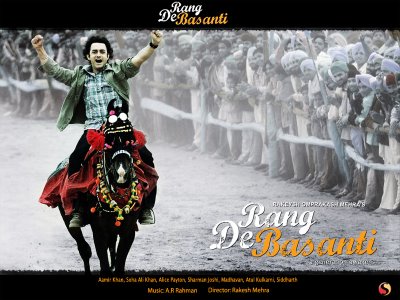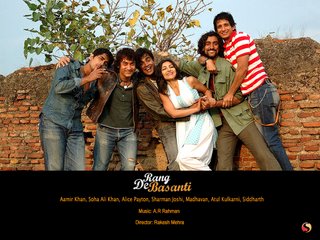
Rang De Basanti - Attainable Utopia
Utopia, the ideal, ever since recognized by Plato in the 5th century BC, almost remains an ellusive term - always thought of, but seldom seen. It is for the attainment of this utopia, that the dabblers of art have long pitted their brains in the creation of. This has consequently led to the creation of timeless classics, be they in the form of books, paintings and even cinema - which is also one of the reasons leading to the creations of the superhero, a Batman or a Superman, someone whom we hoped would have lived.
Then in the early 19th century, came the sudden outburst of realism, of depicting things as they were, without corrupting the end users thoughts with imaginative nonsense. After all, why write about Superman, when no such person or planet actually exists? This feature, specially developed in communist countries, like the earstwhile USSR, soon became the dominant literary ideology of the times. Human beings now wanted to test their rationality, instead of getting wayled into an imaginary world. Aristotle's characters of magnitude, got replaced by the common man - new stories began to unravel themselves through people we saw around us. However the search for the ideal still continued through these stories, though their grandeur was far simpler now and constricted to mundane affairs, not the creation of an ideal republic like Plato.
Rakeysh Omprakash Mehra's second directorial venture keeps with the module of the new quest of the ideal and by Jove does it succeed! Telling the story of a group of friends, Mehra connects the nations past and the future and miraculously succeeds in converging the two tangents. And that is where the Utopia lies - just like our freedom fighters believed in the utopia we are abusing today, these boys and girls believe in an utopia which they believe they need to create. What is more significant in the storyline is the convergence of nationality along with the convergence of time, overriding all petty idiosyncrasies that the youth hold today.
To cut across to the main story now, it begins with a young english filmmaker, Sue (Alice Patten), all set to eulogize the extremist freedom fighters of India through a documentary. However things don't begin on a positive note for her, as the financers now realize that only Gandhi sells. Abusing them in Hindi, she arrives in India to start rolling, remaining optimistic to the very end.
Here comes in Sonia (Soha Ali Khan), who is her contact in India. They begin with their auditions, only to be thoroughly disappointed (and the viewers thoroughly amused). Sonia decides that Sue needs a break from this comic montage and sets out to meet her friends and introduce Sue to some fun. Now enter poet, philosopher Aslam (Kunal Kapoor), Karan (Siddharth), Sukhi (Sharman Joshi) and of course, the very best DJ (Aamir Khan). They are soon joined by the fanatical student union leader Lakshman (Atul Kulkarni) and a distaste between the latter and the group is quickly established.
Sue then decides that this band would be ideal to fill in the shoes of the characters in her movie. However, the potential actors do not think so ..... they belive that the world she wants to create is a farce, something absolutely untrue. They spit on this freedom and pronounce doomsday for the nation. Some coaxing leads them to the stage before the camera, but the spirit is still ellusive. Heroic references and statements are made fun of and the finger on the lips indicate "Maut ki ungli" (the finger of death).
The comedy progresses rapidly, till the news channels report the death of their friend, Flight Captain Ajay Rathode (R. Madhavan), flying a rickety MIG - 21. An under-current flows through them. They wake up. The Defense Minister aggrevates the issue by proclaiming Ajay to be a bad pilot. This adds fuel to the fire. They stage a dharna in front of India Gate, the country's insignia to honour the unknown soldier. The Defense Minister sends in the cops and brutally breaks up the peaceful protest.
Lakshman sees his former mentor ordering and overseeing the police proceedings. After a few seconds, the latter rolls up his window and exits from the scene. Another realisation draws on him personally - the ideals of his party, which he had believed in all this while, suddenly die out before him. His belief that Muslims belong to another nation and other pseudo-nationalistic views are shattered. He looks around to see mass-destruction on innocent protestors demanding justice. He sees Aslam being whacked by a policeman - he forgets the previous interactions between the two and charges at the policeman, snatches his stick and uses it on him itself. Such scenes are seldom seen in world cinema, comparable poorly to Eisenstein's famous "Oddessa Steps" in Battleship Potemkin.
It is at this point, lost for peaceful alternatives, that the group, now with a commitant Lakshman, decide to gun down the minister - Bhagat Singh, Chandrashekhar Azad and Rajguru live on. They complete the impossible, only to have posthomous awards and recognitions thrusted upon the crook. Their objective is now thwarted. Therefore they once again return to the past - like Bhagat Singh and Batukeshwar Dutt, they surrender themselves, letting the world decide on their actions.
With the last scene, inspired from the Western classic Butch Cassidy and the Sundance Kid, Mehra leaves a great impact on the minds of a certain faction of the youth - now just a fraction of the total youth population; the other refer to the last few scenes as comic relief - because they are still a part of the youth as potrayed in the first half of the movie. I wonder if they will ever progress to the second stage, but that is the omnipresent, ellusive Utopia. However, there is the other faction who stirred at the climax and that is why I say that the movie proclaims attainable utopia, something very difficult to contain in any work of art.
Now returning to the movie, I need not add anything about the filmmaker itself - I think my earlier paragraphs are proof enough of his prowess. On the technical front, Binod Pradhan's camer is lyrical and so is the editing. A R Rahman creates tunes that blend in with the story line. The songs are brilliant and the background score is simply stunning - this belongs in the hall of fame.
Speaking of performances, everybody has delivered to the T. Kunal Kapoor looks simply stunning with his locks and stuble, Siddharth gels as the cool introvert, Sharman Joshi is a revelation and Soha just falls short of her performance in Rituparno Ghosh's Antarmahal. Nothing needs to be said about Atul Kulkarni, who has proved his mettle over the years and Alice Patten is the best import from the overseas so far in the Indian film industry.
However, the movie simply belongs to Aamir Khan. Playing a character fifteen years younger than himself, Aamir excells and breathes life into the movie. Anything said about his performance would be an understatement.
Truly, after decades, theatres around the counrty are running responsible reels, reminding us of why we go to the movies in the first place.

2 comments:
true...
simply outstanding..
watt a movie and add to it such a review..
bravo man.. i mean such research work and going into the skin of all the actors as well as the directors u have added another feather to rang de basanti's cap..
i wish anybody from there crew cud read it..
its great..
keep the gud ones coming
if dey will b e so gud .. m sure to comment on each
hello...
Now when you are talking about rang de basanti... im sure to say something.. though im quite at a loss of words here..
though we have had n no of discussions abt the movie.. this definately does some up all of that...
its a truly phenomenal work of art n now definately a benchmark fr many many yrs to come...
( ofcourse "our" shadow lines isn't included here.....!!!!)
N ya.. KUnal kapoor is AWWEeeeeeeEESSSSSooommmmeeeeeEE!!!
p.s-btw.. worse than ya...?? wat was that??
Post a Comment